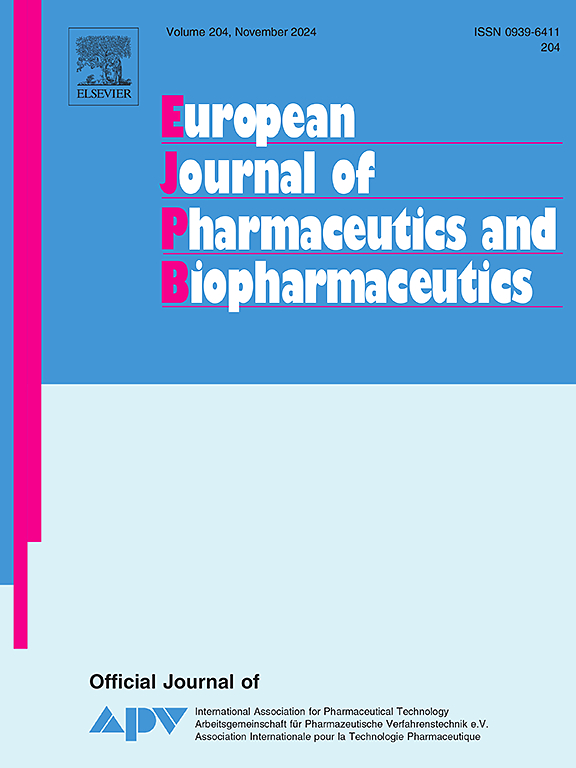Preparation of dual drug-loaded polymer nanoconjugate to enhance treatment efficacy for ovarian cancer cells
IF 4.4
2区 医学
Q1 PHARMACOLOGY & PHARMACY
European Journal of Pharmaceutics and Biopharmaceutics
Pub Date : 2024-10-09
DOI:10.1016/j.ejpb.2024.114526
引用次数: 0
Abstract
Ovarian cancer is the deadliest gynecological malignancy, representing 2.5 % of all female cancers and accounting for 5 % of female cancer-related fatalities. Despite numerous strategies in its treatment, the disease shows a high recurrence rate and a low survival rate. Consequently, there is a growing focus on targeted therapies in ovarian cancer treatment. It is well-known that VEGFR and LPA pathways undergo alterations in ovarian cancer and stimulate survival, adhesion, migration, invasion, tumor growth and angiogenesis. Cabozantinib (CBZ) is a multi-receptor tyrosine kinase inhibitor that effectively targets MET, VEGFR-1, 2, 3, FLT3, c-KIT, and RET. Ki16425 is a selective inhibitor of LPA receptors 1, 2, and 3. Therefore, targeting LPA receptors and combining with VEGFR inhibitor is a strategic approach for ovarian cancer treatment. In this study, it was aimed to prepare polymer-drug nanoconjugate for both VEGFR and LPAR inhibition. For this, O-(2-Carboxyethyl) polyethylene glycol (PEG5000) which advantages are known in cancer studies, was chosen as the carrier system, and a nanoconjugate containing Ki16425 and CBZ (Ki-PEG-CBZ) was synthesized and its potential was evaluated. Initially, CBZ and Ki16425 were conjugated to the PEG5000 through pH-sensitive hydrazone and ester bonds. After nanoconjugate characterization, in vitro release and its ovarian cancer treatment potential were evaluated on A2780, OVCAR3 and SKOV3 ovarian cancer cell lines. A nanoconjugate was obtained with a particle size of 169 ± 15.23 nm, a zeta potential of −13.5 ± 1.21 mV, and a release profile lasting 48 h, containing CBZ and Ki16425 with drug loading efficiencies of 73.71 ± 0.53 % and 77.72 ± 2.51 %, respectively. In vitro studies have demonstrated that Ki-PEG-CBZ is highly effective against ovarian cancer. We suggest that the developed polymer-drug nanoconjugate is an effective and safe nanoconjugate for the treatment of ovarian cancer.

制备双重载药聚合物纳米共轭物,提高对卵巢癌细胞的治疗效果。
卵巢癌是最致命的妇科恶性肿瘤,占所有女性癌症的 2.5%,占女性癌症死亡人数的 5%。尽管治疗卵巢癌的策略层出不穷,但该病的复发率高、存活率低。因此,卵巢癌治疗中的靶向疗法日益受到关注。众所周知,卵巢癌的血管内皮生长因子受体(VEGFR)和LPA通路会发生改变,并刺激肿瘤的生存、粘附、迁移、侵袭、生长和血管生成。卡博替尼(CBZ)是一种多受体酪氨酸激酶抑制剂,可有效靶向 MET、VEGFR-1、2、3、FLT3、c-KIT 和 RET。Ki16425 是 LPA 受体 1、2 和 3 的选择性抑制剂。因此,靶向 LPA 受体并结合 VEGFR 抑制剂是治疗卵巢癌的一种战略方法。本研究旨在制备同时抑制血管内皮生长因子受体和 LPAR 的聚合物-药物纳米共轭物。为此,研究人员选择了在癌症研究中具有众所周知优势的 O-(2-羧乙基)聚乙二醇(PEG5000)作为载体系统,合成了含有 Ki16425 和 CBZ 的纳米共轭物(Ki-PEG-CBZ),并对其潜力进行了评估。最初,CBZ 和 Ki16425 通过 pH 敏感的腙键和酯键与 PEG5000 共轭。纳米共轭物表征后,在 A2780、OVCAR3 和 SKOV3 卵巢癌细胞系上对其体外释放及其治疗卵巢癌的潜力进行了评估。得到的纳米共轭物粒径为 169 ± 15.23 nm,zeta 电位为 -13.5 ± 1.21 mV,释放时间持续 48 h,其中含有 CBZ 和 Ki16425,药物负载效率分别为 73.71 ± 0.53 % 和 77.72 ± 2.51 %。体外研究表明,Ki-PEG-CBZ 对卵巢癌非常有效。我们认为,所开发的聚合物-药物纳米共轭物是一种治疗卵巢癌的有效、安全的纳米共轭物。
本文章由计算机程序翻译,如有差异,请以英文原文为准。
求助全文
约1分钟内获得全文
求助全文
来源期刊
CiteScore
8.80
自引率
4.10%
发文量
211
审稿时长
36 days
期刊介绍:
The European Journal of Pharmaceutics and Biopharmaceutics provides a medium for the publication of novel, innovative and hypothesis-driven research from the areas of Pharmaceutics and Biopharmaceutics.
Topics covered include for example:
Design and development of drug delivery systems for pharmaceuticals and biopharmaceuticals (small molecules, proteins, nucleic acids)
Aspects of manufacturing process design
Biomedical aspects of drug product design
Strategies and formulations for controlled drug transport across biological barriers
Physicochemical aspects of drug product development
Novel excipients for drug product design
Drug delivery and controlled release systems for systemic and local applications
Nanomaterials for therapeutic and diagnostic purposes
Advanced therapy medicinal products
Medical devices supporting a distinct pharmacological effect.

 求助内容:
求助内容: 应助结果提醒方式:
应助结果提醒方式:


